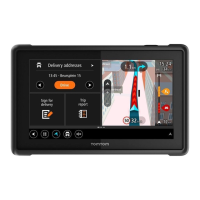21
TomTom Bridge Hub
The memory card slot is located on the bottom of the device under a cover as shown below.
Transferring files to your device
You can transfer personal files, for example POI lists, photos or music files, to the TomTom
BRIDGE internal memory. This allows you to use apps on the device to view POIs, photos or play
music.
You can also transfer files from the TomTom BRIDGE internal memory to your computer.
Note: Not all file types can be opened by the device.
Note: You can transfer files from a computer running one of the following operating systems:
- Windows 7 or higher
- Apple OS X 10.5 or higher
- Some Linux distributions of version 14.04 or higher.
To transfer files, do the following steps:
1. For the TomTom BRIDGE Terminal, connect the device to your computer using a USB cable,
then switch your TomTom BRIDGE on.
Note: You cannot use the mount to connect your device to your computer.
Note: You should plug the USB cable directly into a USB port on your computer and not into
a USB hub or USB port on a keyboard or monitor.
For the TomTom BRIDGE Hub, use the black USB port and a USB cable to connect the device
to your computer. This is port K shown here: About your TomTom BRIDGE Hub
.
2. On your computer, open a file manager program.
Your TomTom BRIDGE appears in your computer's files system as TomTom Bridge.
3. Open the TomTom BRIDGE Internal Storage folder.
4. Copy files from your computer to a folder on your TomTom BRIDGE, or from your TomTom
BRIDGE to your computer.
Tip: To keep the device organised, copy the files to a folder with a relevant name. For exam-
ple, copy your music files to the Music folder.
5. Disconnect the TomTom BRIDGE from your computer.

